Смотрю даташит на THS4551, стр 52 и не могу понять, каким образом они вычислили необходимый noise gain на ВЧ :
• Set the THS4551 output common-mode voltage at midsupply by grounding the VOCM pin.
• Control the input pin operating voltage by sinking the center current out of the DAC to the –2.5-V supply with
precision 402-Ω resistors.
• Set the gain for the complementary current output signal from the DAC by selecting the feedback resistor to
be 750 Ω. Set this resistor to keep the resulting output swing to be less than the available 9-VPP differential
swing.
• Control the bandwidth in this differential transimpedance stage to 88 kHz using the 2.4-nF feedback capacitor
on each side.
• Increase the high-frequency noise gain to 17.7 V/V by adding a differential input capacitor of 20 nF.
• Isolate these feedback capacitors with a series 4.4-Ω resistor in series with the feedback capacitors.
Речь о вычислении ёмкости конденсатора между дифф. входами

• Set the THS4551 output common-mode voltage at midsupply by grounding the VOCM pin.
• Control the input pin operating voltage by sinking the center current out of the DAC to the –2.5-V supply with
precision 402-Ω resistors.
• Set the gain for the complementary current output signal from the DAC by selecting the feedback resistor to
be 750 Ω. Set this resistor to keep the resulting output swing to be less than the available 9-VPP differential
swing.
• Control the bandwidth in this differential transimpedance stage to 88 kHz using the 2.4-nF feedback capacitor
on each side.
• Increase the high-frequency noise gain to 17.7 V/V by adding a differential input capacitor of 20 nF.
• Isolate these feedback capacitors with a series 4.4-Ω resistor in series with the feedback capacitors.
Речь о вычислении ёмкости конденсатора между дифф. входами


